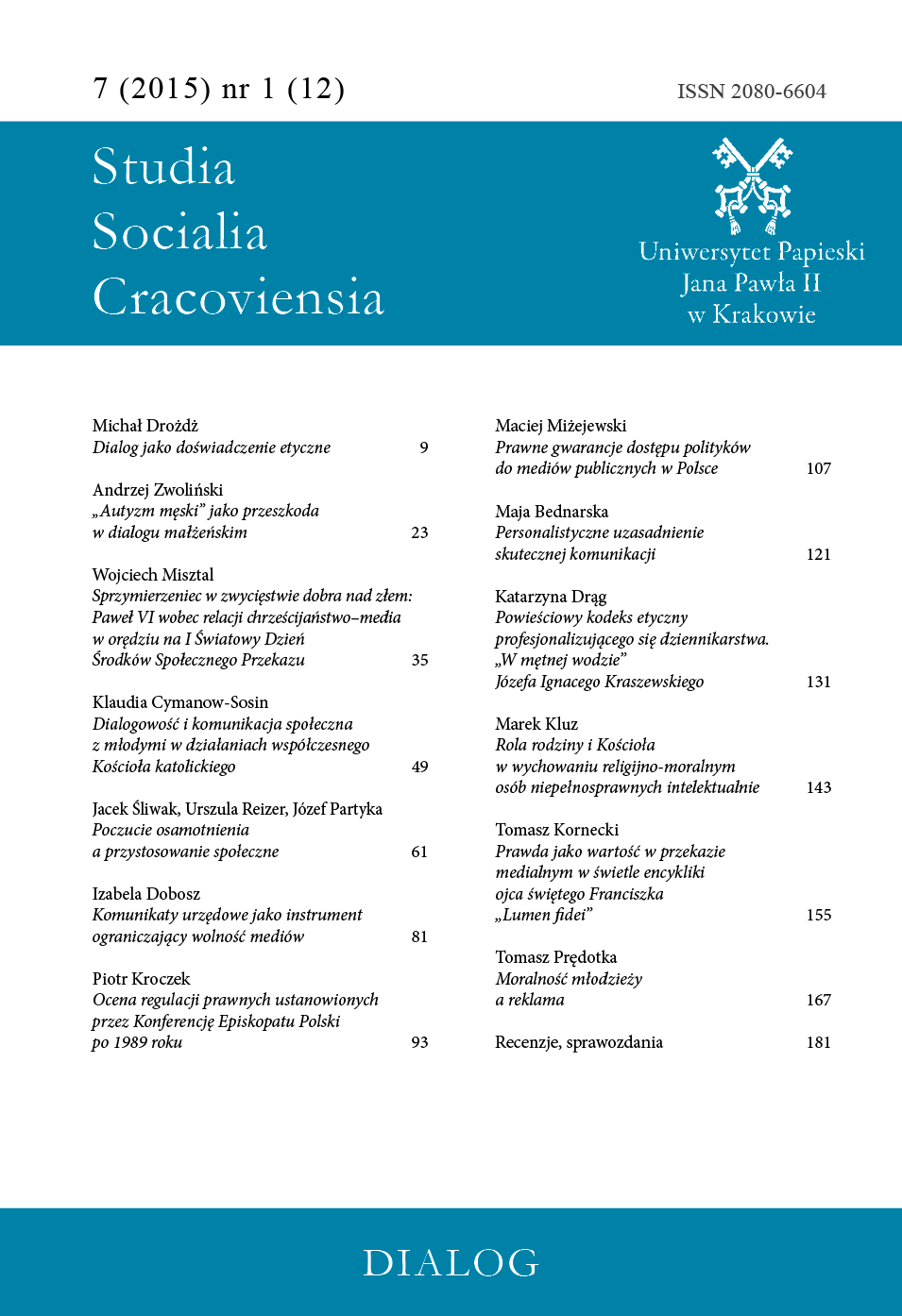“Male autism” as an obstacle to matrimonial dialogue
DOI:
https://doi.org/10.15633/ssc.976Keywords:
dialog małżeński, autyzm męski, ojcostwo, komunikacjaAbstract
One of the obstacles in the dialogue in marriage is ignoring the existence of mental distinction between man and woman. Each of them experiences his or her own value otherwise. Self-esteem is the foundation of well mental being. Interest and value to your partner and to other people are depended on this basic mood. Observing the behavior of some men, we can say that the male way of thinking is typical for people affected by autism. According to the psychology knowledge, autism is a disorder manifested by serious limitation in intellectual and emotional functioning. This term is used because it describes the isolation of a person against accepted social behavior. This term is used because it describes the isolation of a person against accepted social behavior. This is important in shaping the communication between spouses, because it forces the wife to understand and accept the male understanding of dialogue. The husband speaks to denounce some kind of content, pass it on, communicate, when a woman expresses a bond with others by the mere fact of conversation. This difference requires the knowledge and mutual understanding of the two concepts of dialogue: female and male.
References
Artymiak M., Pomiędzy mężczyzną a kobietą. Sztuka porozumiewania się, Kraków 2010.
Aryle M., Psychologia stosunków międzyludzkich, przekł. W. Domachowski, Warszawa 1999.
Błasiak A., Oddziaływanie wychowawcze w rodzinie, www.opoka.org.pl/biblioteka/I/ID/ wam_2012_w_rodzinie_02 (20.11.2014).
Błasiak A., Znaczenie więzi rodzinnej dla funkcjonowania rodziny, [w:] Katecheza drogą do Boga, red. I. Popiołek, S. Cieślak, Kraków 2011, s. 207–215.
Brzoza A., Godność osoby jako podstawowe kryterium moralności, [w:] W kręgu chrześcijańskiego orędzia moralnego, red. M. Biskup, T. Reroń, Wrocław 2000, s. 85–94.
Cieśla J., Rany po słowach. Rozmowa z dr Anną Piekarską, „Polityka” 2012 nr 22, s. 34–35.
Dziewiecki M., Psychologia porozumiewania się, Kielce 2000.
Frankl V. E., Człowiek w poszukiwaniu sensu, Warszawa 2009, s. 167.
Frydrychowicz S., Komunikacja interpersonalna w rodzinie a rozwój dorosłych, [w:] Rodzina a rozwój człowieka dorosłego, red. B. Harwas-Napierała, Poznań 2003, s. 101–122.
Funes N., Kochanie, rozpuściłem dzieciaki! Rozmowa z francuskim psychologiem Didierem Pleux, „Forum” 2013 nr 15, s. 32–34 (za: „Le Nouvel Observateur” 17.01.2013).
Gałkowski T., Fascynacje i nadzieje w badaniach nad autyzmem, [w:] Autyzm wyzwaniem naszych czasów, red. T. Gałkowski, J. Kossewska, Kraków 2004, s. 10–18.
Grygier U., Sikorska I., Mój uczeń pracuje inaczej, Kraków 2008.
Grzesiuk L., Studia nad komunikacja interpersonalną, Warszawa 1994.
Iskra J., Doświadczenie trudności w relacjach interpersonalnych. Badania kobiet, [w:] Doświadczenia człowieka, red. J. Iskra, M. Artymiak, Kraków 2013, s. 45–57.
Karoń-Ostrowska A., Czy kobiety są bardziej pobożne?, [w:] Duchowość kobiety, red. J. Augustyn, Kraków 2007, s. 132–145.
Kastory B., Zmysły w rozsypce, „Newsweek Polska” 2008 nr 14, s. 68–73.
Kruk-Lasocka J., Autyzm czy nie autyzm? Problemy diagnozy i terapii pedagogicznej małych dzieci, Wrocław 2003.
Krzemionka D., Wojciszke B., Dla mężczyzny sercem jest świat. Dla kobiety serce światem, „Charaktery” 2010 nr 4, s. 109–114.
Malessa A., Giesekus U., Mężczyźni nie są skomplikowani, przekł. U. Poprawska, Kraków 2009.
Mastalski J., Zarys teorii wychowania, Kraków 2002.
McKernan T., Mortlock J., Autyzm w centrum uwagi, tłum. E. Krasodomska, Kraków 2004.
Mosty zamiast murów. O komunikowaniu się między ludźmi, red. J. Stewart, tłum. J. Doktór, Warszawa 2000.
Opalach C., Komunikacja w życiu rodziny, „Nurt SVD” 2011 nr 2, s. 48–59.
Pelamatti L., Bolesna miłość, przekł. E. Łukaszyk, Kraków 2005.
Pytches M., Nie jesteś już dzieckiem. Droga ku pełni dojrzałości wewnętrznej, tłum. W. Kustra, Kraków 1993.
Regionalny Ośrodek Polityki Społecznej w Krakowie, Mediacje rodzinne w praktyce, Kraków 2009.
Satir V., Terapia rodziny, przeł. O. Waśkiewicz, Gdańsk 2000.
Shields S. A., Mówiąc od serca, przekł. J. Margański, Kraków 2004.
Smardz M., Zdort M., Kląć jak… dziecko, „Uważam Rze” 2012 nr 28, s. 42–43.
Stoppard J., Gruchy G., „Personality and Social Psychology Bulletin” 1993 nr 19, s. 144–156.
Szopiński J., Małżeństwo i rodzina, http://pedagogikaspecjalna.tripod.com/notes/ marriagefamily2.html (20.11.2014).
Szopiński J., Rozwój kontaktu osobowego we współczesnym małżeństwie, „Zdrowie Psychiczne” 1973 nr 4, s. 28–34.
Śmigulec A., Instrukcja obsługi chama, „Gazeta Wyborcza. Duży Format” 27.02.2014, s. 16–18.
Terpińska K., Rodzina i ty. Fenomenologia wiązania, Warszawa 2008.
Tomaszewski K. L., Dlaczego nie umiemy rozmawiać? Dlaczego rozmawiamy tak, aby niczego nie powiedzieć?, „W Sieci” 2013 nr 6, s. 43.
Zalewska S. L., Style komunikacji, [w:] Słownik małżeństwa i rodziny, red. E. Ozorowski, Warszawa–Łomianki 1999, s. 431.
Zalewska S. L., Syndrom pustego gniazda. Małżeństwo i rodzicielstwo po usamodzielnieniu się dzieci, Warszawa 2010.
Downloads
Published
Issue
Section
License
Authors who publish with this journal agree to the following terms:
- Authors retain the copyright and full publishing rights without restrictions, and grant the journal right of first publication with the work simultaneously licensed under a Creative Commons Attribution 4.0 International License that allows others to share the work with an acknowledgement of the work's authorship and initial publication in this journal.
- Authors are able to enter into separate, additional contractual arrangements for the non-exclusive distribution of the journal's published version of the work (e.g., post it to an institutional repository or publish it in a book), with an acknowledgement of its initial publication in this journal.
- Authors are permitted and encouraged to post their work online (e.g., in institutional repositories or on their website) prior to and during the submission process, as it can lead to productive exchanges, as well as earlier and greater citation of published work (See The Effect of Open Access).

